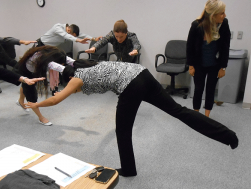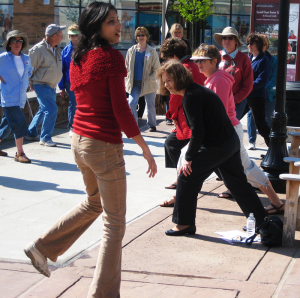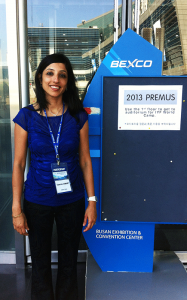"Living with a chronic pain condition can make you question whether its possible for you to get better, to go back to activities you love. Suparna's approach presupposes that you will make a full recovery, using activity instead of rest. To feel like a normal active person instead of a rare case of an obscure and incurable ailment is already a powerful first step; and the rest of the program fulfills this promise."
Info for Individuals…..
We are a society that assumes that some physical pain is a part of life. Everyone has neck or back pain, right? We discount it- either we sat too much, or the wrong way, or it must be that long drive or a strain while sleeping. I watch people walking around in the malls, with poor posture and often rubbing their necks or shaking out their arms while carrying bags. Often, the view is that aging means pain, which is quite untrue, especially with musculoskeletal disorders. Sure, aging is inevitable, but suffering is not.
It is estimated that 100 million Americans today suffer from chronic pain (source: Institute of Medicine). Healthcare professionals are frequently stumped by it, and sufferers get tossed from one health practitioner to another, being treated with medications and shots, maybe even surgeries with no relief of symptoms. Chronic pain is thought to be “incurable”, and people with chronic pain are doomed to “live with it”, often desperate to find a just a few hours of relief.

Chronic musculoskeletal pain is a syndrome which is cumulative, with an interaction of several body systems. Realizing these interactions, and treating chronic pain holistically renders amazing results. One simply needs to “connect the dots” between the different components of the chronic pain syndrome. The OAS program will help identify these components, explain the interactions, and provide solutions based on this. Specific protocols will be developed, based on your specific chronic pain syndromes and injuries.
The human body is an amazing compensating machine that adjusts to an injury, doing whatever it can to keep the injured body functioning. Unfortunately, the body systems do not function in a vacuum and the compensatory mechanisms themselves cause effects that feed back into the causes, forming a vicious cycle. The good news is that the human body is also an amazing healing machine, and as long as all the compensatory mechanisms are addressed and “unraveled”, the body can heal and function is restored. The causes of the pain need to be addressed, not just the symptoms.
Chronic pain is completely preventable. As we get more sedentary and technology starts dominating our lives, the incidence of musculoskeletal pain is increasing. Our children are at high-risk: dealing with computers, video games, heavy back packs, sedentary lifestyle, obesity, high pace of life and early stress responses. If we don’t start identifying and treating the pieces of the chronic pain puzzle, we will evolve into a very unhealthy society. Prevention strategies are a part of this program also.
Is it all “in my head”?
 The pain you feel is real. Over time, certain physiological changes take place in your body and brain that perpetuate pain cycles. Thus, one the physical causes of the pain have been identified and addresses, the physiological changes must be stopped and the brain re-trained (the brain is very plastic-this is not as complicated as it sounds!). Thus, the nervous system is definitely involved in the chronic pain scenario; although stress is caused by the pain and also is a contributing factor, most often, it’s not the only piece of the chronic pain puzzle.
The pain you feel is real. Over time, certain physiological changes take place in your body and brain that perpetuate pain cycles. Thus, one the physical causes of the pain have been identified and addresses, the physiological changes must be stopped and the brain re-trained (the brain is very plastic-this is not as complicated as it sounds!). Thus, the nervous system is definitely involved in the chronic pain scenario; although stress is caused by the pain and also is a contributing factor, most often, it’s not the only piece of the chronic pain puzzle.
Who is the OAS candidate?
Typically, patients who approach me have been to several different healthcare professionals and tried “everything”- I am their “last resort”. I am hoping to cut short the frustrating journey to recovery- the earlier you catch the symptoms and treat them, the better it is (remember the compensatory mechanisms that complicate things?!). So, you can approach OAS as soon as you start feeling symptoms or even if you are a symptom-veteran. Earlier the better, but in my experience, it’s never too late to get your life back.
What should one expect from the OAS program?
It may seem miraculous when the body starts healing and the symptoms start disappearing, but there is nothing magical about it. When you make an appointment to speak with me, we’ll meet on-line and based on our conversation, I’ll give you a detailed program to follow- a program specifically designed for you. We’ll schedule follow-up appointments every 3-4 weeks, and I’ll upgrade/tweak the program at these times. It’s like putting down a foundation and then building up on it gradually. In a sense, we’ll re-build a healthy body from the ground up. Gradually, I’ll instruct you in the initiation and progression of different activities till you meet your goals. If you stick to your end of the deal, it doesn’t take long for you to start noticing the changes.
Why doesn’t everyone else do it?
 I ask myself the same question daily. Injuries and their progression are very logical and so is the treatment process. All I can think of is that all the “suspects” are not being addressed, all the “dots” are not being connected and maybe, also, that there is a certain fear surrounding the treatment of chronic conditions, combined with a feeling of helplessness due to either lack of experience or the necessity to stay within protocols. One thing is for sure- protocols don’t work. The treatment must be individualized – the way each body compensates is unique, and the treatment must address this unique process. Also, every individual’s response/reaction to intervention is different, and the program must be tweaked to target these changes. Thus, one needs an arsenal of techniques to identify what will work, and then to make changes as needed. It could possibly be my East-West combination approach, or perhaps the fact that I’ve been exclusively treating chronic and cumulative trauma for 17 years, but I have gathered enough arrows in my quiver to make a difference.
I ask myself the same question daily. Injuries and their progression are very logical and so is the treatment process. All I can think of is that all the “suspects” are not being addressed, all the “dots” are not being connected and maybe, also, that there is a certain fear surrounding the treatment of chronic conditions, combined with a feeling of helplessness due to either lack of experience or the necessity to stay within protocols. One thing is for sure- protocols don’t work. The treatment must be individualized – the way each body compensates is unique, and the treatment must address this unique process. Also, every individual’s response/reaction to intervention is different, and the program must be tweaked to target these changes. Thus, one needs an arsenal of techniques to identify what will work, and then to make changes as needed. It could possibly be my East-West combination approach, or perhaps the fact that I’ve been exclusively treating chronic and cumulative trauma for 17 years, but I have gathered enough arrows in my quiver to make a difference.
